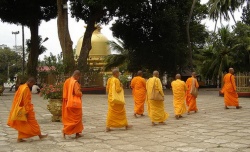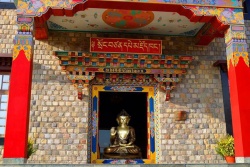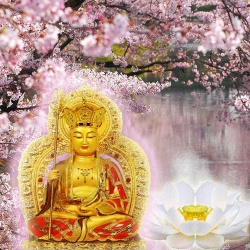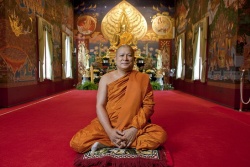Gaining Confidence in the Tantra Method
Dr. Alexander Berzin
In the traditional presentation of lam-rim, the graded stages of the path, with an intermediate level motivation you have renunciation and then practice the three higher trainings – in ethical discipline, concentration, and discriminating awareness of voidness (emptiness). With that discriminating awareness, you discriminate between how things do exist and how they don’t exist). The emphasis is on having the motivation, namely renunciation, that accompanies that awareness. That’s because just understanding voidness without any specific aim of what you’re doing it for, then just like with any positive action, basically it will build up positive karmic force, which will just improve your samsara. As a result, you could have a nice discussion around the coffee table about voidness, but it’s not going to get you any further on the spiritual path, and you’re not going to be able to understand it very deeply.
And so the emphasis there is on having the proper motivation so that you can have a proper dedication. If you dedicate the karmic force – here it wouldn’t necessary be a karmic force (that’s a big debate, whether it’s karmic or not) – you would dedicate whatever comes from that toward liberation. Or with bodhichitta, you dedicate it toward enlightenment. It’s like when you do something positive, then the default setting on the internal karma computer is that it goes into the “improve samsara” folder. But you have to actually very consciously press the button to save in either the “for liberation” folder or “for enlightenment” folder – that’s why the dedication is so absolutely essential – and then that positive force will contribute toward liberation or enlightenment.
See: The Two Collections: Two Networks.
In the lam-rim, then, the emphasis is on the motivation. Gain renunciation. That comes first. And then the three higher trainings. And they don’t really explain it very deeply at all in the intermediate scope, where you’re aiming for liberation, but they then explain it more fully once you’ve gotten the bodhichitta motivation. But His Holiness the Dalai Lama puts the emphasis the other way around, which is that you really need the understanding of voidness in order to have proper renunciation or bodhichitta. This is the way Nagarjuna presents it in his Commentary on (the Two) Bodhichittas (Byang-chub sems-kyi ‘grel-ba, Skt. Bodhichittavivarana).
This is similar to what you find in the Seven Point Mind Training (Blo-sbyong don-bdun-ma). I call it cleansing of attitudes lojong (blo-sbyong). That’s usually translated as mind training, but that sounds as though you’re just intellectually training yourself to have a better memory, so I don’t like that term. It literally means “to cleanse away negative attitudes and transform them into positive attitudes.” In that text it has first the presentation of deepest bodhichitta, before the presentation of relative bodhichitta, and it’s only in the Gelug tradition that it’s changed. They say that this order is according to some special oral lineage, and they put it toward the end of the text. But the earlier version of the text, has it first. That’s the original order of it. So it’s the same idea.
Well, it’s interesting. You can look at it from several points of view. One point of view is: How do you know that liberation is possible or enlightenment is possible? And if you are not convinced that it’s possible, then how can you sincerely aim to achieve that, either liberation or enlightenment? So this gets into the whole discussion of the natural purity of the mind and the disturbing emotions and attitudes, which are based on unawareness of voidness, usually called ignorance, but are based on that (that supports the disturbing emotions and attitudes).
When you look at beginningless time, you have the mental continuum. Mental continuum from the point of view of logic has no absolute beginning, because everything has to have a previous moment as its cause, and it can’t just arise from nothing. If it arose from nothing, then there’s no cause. Or it could arise from any cause, His Holiness was saying, which means the whole thing becomes absurd and chaotic. So that has beginningless continuity, and so do unawareness, or ignorance, and the disturbing emotions, and so do the positive qualities – love, compassion, and so on.
Then you have to ask: Which one can be stronger? Because they say that the positive qualities have no beginning and no end, just as the mental continuum has no beginning and no end, whereas the unawareness and the disturbing emotions and distorted attitudes and everything have no beginning, but do have an end (you can get rid of them). So why? And the reason why, His Holiness explained, is that you look at what supports them, and what supports the so-called correct ones and the incorrect ones is quite different. You can replace the negative ones with the correct understanding. Correct understanding and incorrect understanding are mutually exclusive (you can’t simultaneously correctly understand and incorrectly understand). So then the question, as I said, is: Which is stronger? Which is going to really do it? And what will really do it is the correct understanding – because that’s based on reason, which supports it – and the more you strengthen that, the less suffering you have. And that’s the whole point, what Buddhism is talking about, is how to get rid of suffering.
And so if that’s what your aim is… Theoretically you could say your aim was to have more suffering. Then you would say that unawareness was better because it brings you more suffering. But if your aim, as part of the basic nature of sentient beings, is that you want to be happy and you don’t want to be unhappy, then the correct understanding is stronger: it’s based on logic, and it gets rid of suffering. Whereas the more you examine the incorrect understanding, based on logic… This of course is on the premise that logic is correct. Not everybody agrees that there is such a thing as logic and it is correct. But if you accept that premise, the more that you work on the side of unawareness and confusion, the more suffering you get, and it’s not supported by logic.
Well, an arya is able to have non-conceptual cognition of voidness (so, able to have absolutely no grasping of true existence in total absorption on voidness, and the mind doesn’t even make an appearance of true existence). At that point there is a total absence of any appearance, or believing in that appearance, of true existence. That’s why they’re the Arya Sangha, the Sangha refuge. They’ve gotten it for a little while.
So that starts the process, and that’s going to get rid of a little bit of the distorted side – the doctrinally-based disturbing emotions, the ones that are based on hearing an incorrect tenet system and believing in it (basically one of the Hindu or Jain systems). If you could get that state of mind – the total absorption on voidness, with not even appearance-making of true existence, let alone believing in it – that all the time, which is what a Buddha does, only a Buddha does, then you’ve gotten rid of all the unawareness; you’ve gotten rid of all the distorted side. That’s why all of these can be eliminated.
So if you understand that, and if you understand that in order to get there you have to build up a tremendous amount of positive force and dedicate it toward that goal, then you have an understanding of, as His Holiness the Dalai Lama says, the two truths and an understanding of the four truths, and that leads you to an understanding and conviction in the Three Jewels:
An understanding and conviction that there is such a thing as the Dharma Jewel, which is that state in which there’s the total stopping forever of this distorted side and the full realization of the true path, which is not only the opponent to that but the result of it as well – the understanding of voidness and then having that all the time, so both the path and the result. If you gain understanding in that – well, that’s the Dharma Jewel.
Then the Sangha Jewel. There are those that have a little bit of that understanding sometimes.
And the Buddhas are the ones that have it all the time.
If you understand that, then you can be convinced that there is such a thing as liberation, because the aryas on the path, the Arya Sangha on the path, achieved liberation, part of the way to Buddhahood. And you can be convinced that it’s possible to achieve enlightenment. On that basis, then you can actually have proper renunciation and bodhichitta with confidence that that attainment of liberation and enlightenment is possible. Then the whole discussion gets into that it’s possible for me to achieve that, not just the Buddha or these guys in ancient India achieved it, and for that you need to get into the whole Buddha-nature discussion.
So it’s very important for taking an empowerment like Kalachakra, or any other empowerment, to be very confident in the tantra path. And you can only really get confidence in the tantra path based on, first of all, confidence in the sutra path and confidence that liberation and enlightenment are possible.
Then it’s necessary to understand that really to be able to achieve enlightenment, you need to have that understanding of voidness non-conceptually not only with renunciation behind it, not only with bodhichitta behind it, not only with an enormous amount of what’s usually called the two collections (the two networks, I call them) of positive force and deep awareness, or merit and wisdom – this tremendous positive force, this tremendous… further and further experience of the deep awareness of voidness, so it builds up a habit of it, and the type of deep awareness of conventional truth that sort of goes along with that. But in addition to all of that, the mind that has all of this, what you need is the clear-light mind, the subtlest type of mind. And the reason why you need that is that, first of all, that’s the type of mind that a Buddha has. I mean, everybody has it on a basis level, but everybody has these other grosser levels which are on top of it. A Buddha has exclusively only the clear light level of mind
As for what is important about the clear-light mind, His Holiness explained that you’re missing the full essence of it if all you say that it is subtler than the conceptual mind. It is subtler than all levels of rough minds, both conceptual mental cognition and non-conceptual sensory and mental cognition. It underlies both.
You know the expression “grasping for true existence”? It has two meanings. It means to perceive appearances of true existence and to believe that what appears corresponds to reality. Conceptual cognition does both, but non-conceptual sensory and mental cognition still makes appearances of true existence.
So not only is clear-light mind free of the conceptual mind that believes in these deceptive appearances of true existence that our mind makes appear, but it is also subtler than the level of mind that makes that appearance of true existence, which would be not just the conceptual level of mind but also the non-conceptual, coarse level of mind. When we see, that’s non-conceptual sensory cognition, and when we dream, that’s non-conceptual mental cognition of subtle sights, sounds, and so on. It’s not imagination; it’s not the same (it’s more vivid in a dream). So clear-light mind is subtler than that coarse non-conceptual level. It doesn’t make appearances of true existence; in other words, the clear-light mind doesn’t have mental fabrication (spros-pa), sometimes translated as “elaboration.”
Because clear-light mind is parted from the mental fabrication of the deceptive appearances of true existence, whereas the grosser levels have that, and because the grosser levels of mind don’t have unbroken continuity – they cease in the short period of death existence, when you only have the clear-light level – and because that clear-light level does have unbroken continuity, then you could say that the clear-light level of mind has to be the actual conventional nature of the mind, and therefore that’s unstained.
It’s similar to the total absorption on voidness; the only difference is that it doesn’t understand what’s happening. In Kedrub Norzang Gyatso’s commentary on Kalachakra, An Adornment for “The Stainless Light,” (Dri-med 'od-kyi rgyan), he explains that with clear-light cognition, you get an appearance like a total absorption on voidness (in other words, no appearance of true existence), but you don’t understand it. So this is why you need the understanding of voidness beforehand in order to apply it at that moment. But clear-light mind is called a similar class cause (rigs-’dra’i rgyu). It’s in a similar class, the same type of animal, as total absorption on voidness.
So on the basis of clear-light mind having unbroken continuity (and it’s the only level of mind that has unbroken continuity), you can say the nature of the mind is not stained by these other levels. So this is what anuttarayoga tantra is all about and its great advanatage: The point is to get to that level and to be able to sustain that level. And if you can sustain that level and add to it the non-conceptual understanding of voidness – which you’re only going to be able to get if you have renunciation and bodhichitta and these two networks, two collections – then you’ve got it, then you’ve got Buddhahood.
So to really take the empowerment fully with conviction, you need the conviction that liberation is possible, enlightenment is possible, the nature of the mind is not stained by these fleeting things – which is not just referring to the conceptual mind, it’s not just referring to the disturbing emotions, but it’s referring to all the grosser levels that make these appearances of true existence, which are the basis for then believing in it – and confidence in the tantra method for actually being able to get to that clear-light level (not having to wait until you die to experience it). Then on that basis, you would really want to practice tantra. You would have full confidence in it.
Based on explanations given by His Holiness the Dalai Lama at the Kalachakra initiation, Toronto, Canada, April 2004




